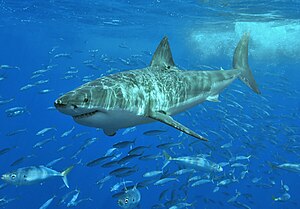 Image via Wikipedia
Image via Wikipedia
In fact there are three main types of unprovoked shark attack, and the experience and chances of survival vary dramatically depending on the behavior and intentions of the shark.
Here is a breakdown of what each one consists of.
Hit-and-run attacks
More often than not sharks will "attack" humans out of curiosity having mistaken them for a seal or other more common form of prey.
These attacks occur in shallow waters and surfing spots. The shark will usually give the swimmer or surfer a single bite before retreating and will often not return, having realized the human is bigger than, or different to, its normal prey.
Sneak attacks
As the name indicates, this attack happens without warning. Unlike hit-and-run attacks, sneak attacks are thought to be the result of feeding or aggression rather than mistaken identity.
The attacks usually happen in deeper waters and will usually involve a number of bites or injuries, often proving fatal.
Bump-and-bite attacks
Similar to sneak attacks, these usually take place in open sea and will tend to involve multiple bites because the shark's intention is to attack the victim, rather than simply investigate.
The difference is in the shark's behavior. Rather than pouncing unexpectedly, the shark will repeatedly circle the victim and bump into them in a sign of aggression before actually attacking them.
Thanks to ::: Florida Museum of Natural History and Nick Collins of the Telegraph
Kathy Dowsett
www.kirkscubagear.com

No comments:
Post a Comment